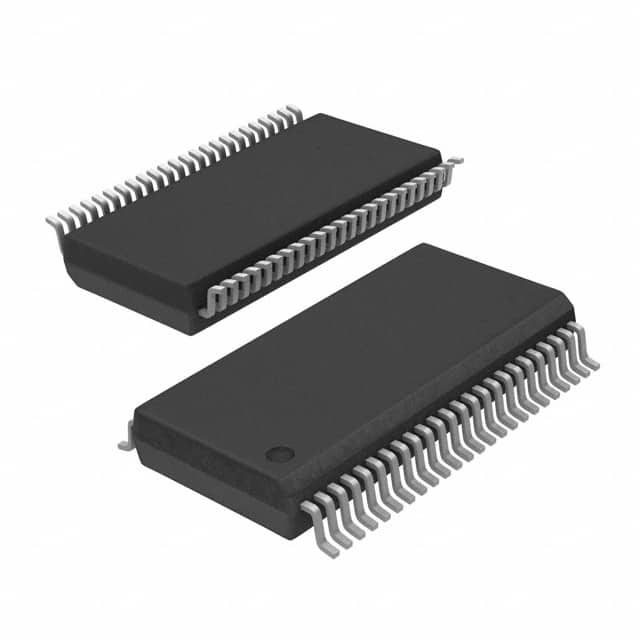Lihat spesifikasi untuk detail produk.

Encyclopedia Entry: 74ABT16245BDGG-Q1J
Product Overview
- Category: Integrated Circuit (IC)
- Use: Signal Buffer/Transceiver
- Characteristics: High-speed, bidirectional, voltage-level translation
- Package: DGG-Q1J (48-pin TSSOP package)
- Essence: The 74ABT16245BDGG-Q1J is a high-performance, octal bus transceiver with 3-state outputs. It is designed to provide voltage-level translation between different logic families.
- Packaging/Quantity: Available in reels of 2500 units.
Specifications
- Logic Family: ABT
- Number of Channels: 8
- Input Voltage Range: 4.5V to 5.5V
- Output Voltage Range: 4.5V to 5.5V
- Propagation Delay: 2.5 ns (max)
- Operating Temperature Range: -40°C to +125°C
- Supply Voltage: 4.5V to 5.5V
- Output Current: ±24 mA
Detailed Pin Configuration
The 74ABT16245BDGG-Q1J has a total of 48 pins. Here is the detailed pin configuration:
- OE (Output Enable) 1
- A1 (Data Input/Output) 1
- B1 (Data Input/Output) 1
- GND (Ground)
- B2 (Data Input/Output) 2
- A2 (Data Input/Output) 2
- OE (Output Enable) 2
- VCC (Supply Voltage)
- B3 (Data Input/Output) 3
- A3 (Data Input/Output) 3
- OE (Output Enable) 3
- GND (Ground)
- A4 (Data Input/Output) 4
- B4 (Data Input/Output) 4
- OE (Output Enable) 4
- VCC (Supply Voltage)
- B5 (Data Input/Output) 5
- A5 (Data Input/Output) 5
- OE (Output Enable) 5
- GND (Ground)
- A6 (Data Input/Output) 6
- B6 (Data Input/Output) 6
- OE (Output Enable) 6
- VCC (Supply Voltage)
- B7 (Data Input/Output) 7
- A7 (Data Input/Output) 7
- OE (Output Enable) 7
- GND (Ground)
- A8 (Data Input/Output) 8
- B8 (Data Input/Output) 8
- OE (Output Enable) 8
- VCC (Supply Voltage)
- DIR (Direction Control)
- GND (Ground)
- NC (No Connection)
- NC (No Connection)
- NC (No Connection)
- NC (No Connection)
- NC (No Connection)
- NC (No Connection)
- NC (No Connection)
- NC (No Connection)
- NC (No Connection)
- NC (No Connection)
- NC (No Connection)
- NC (No Connection)
- NC (No Connection)
- NC (No Connection)
Functional Features
- Bidirectional voltage-level translation between different logic families.
- 3-state outputs allow multiple devices to share a common bus.
- High-speed operation with minimal propagation delay.
- Output enable control for easy bus management.
Advantages
- Enables seamless communication between different logic families.
- Supports high-speed data transmission.
- Allows multiple devices to share a common bus, reducing the number of required pins.
- Provides reliable voltage-level translation with minimal propagation delay.
Disadvantages
- Limited to specific logic families (ABT in this case).
- Requires careful consideration of input and output voltage levels to ensure proper operation.
- May not be suitable for applications requiring very low power consumption.
Working Principles
The 74ABT16245BDGG-Q1J operates by receiving data inputs from one logic family and translating them into compatible voltage levels for another logic family. The direction of data flow is controlled by the DIR pin. When the output enable (OE) pin is active, the device allows bidirectional data transfer. When the OE pin is inactive, the outputs are in a high-impedance state, effectively disconnecting the device from the bus.
Detailed Application Field Plans
The 74ABT16245BDGG-Q1J can be used in various applications that require voltage-level translation
Sebutkan 10 pertanyaan dan jawaban umum terkait penerapan 74ABT16245BDGG-Q1J dalam solusi teknis
Sure! Here are 10 common questions and answers related to the application of 74ABT16245BDGG-Q1J in technical solutions:
Q1: What is the 74ABT16245BDGG-Q1J? A1: The 74ABT16245BDGG-Q1J is a specific type of integrated circuit (IC) that functions as a 16-bit bus transceiver with 3-state outputs.
Q2: What is the purpose of the 74ABT16245BDGG-Q1J? A2: The purpose of this IC is to enable bidirectional data transfer between two buses with different voltage levels or logic families.
Q3: What is the maximum operating voltage for the 74ABT16245BDGG-Q1J? A3: The maximum operating voltage for this IC is typically 5.5 volts.
Q4: Can the 74ABT16245BDGG-Q1J handle level shifting between different voltage domains? A4: Yes, this IC is designed to handle level shifting between different voltage domains, making it suitable for interfacing between systems with different logic levels.
Q5: How many data lines can the 74ABT16245BDGG-Q1J handle? A5: This IC can handle up to 16 data lines, making it ideal for applications requiring parallel data transfer.
Q6: Does the 74ABT16245BDGG-Q1J support 3-state outputs? A6: Yes, this IC supports 3-state outputs, allowing multiple devices to share a common bus without interfering with each other.
Q7: What is the maximum data transfer rate supported by the 74ABT16245BDGG-Q1J? A7: The maximum data transfer rate supported by this IC is typically in the range of several hundred megahertz.
Q8: Can the 74ABT16245BDGG-Q1J be used in automotive applications? A8: Yes, the "Q1J" suffix in the part number indicates that this IC is specifically designed for automotive applications, making it suitable for use in vehicles.
Q9: Does the 74ABT16245BDGG-Q1J have built-in ESD protection? A9: Yes, this IC typically includes built-in electrostatic discharge (ESD) protection, which helps to safeguard against damage from static electricity.
Q10: What package does the 74ABT16245BDGG-Q1J come in? A10: The 74ABT16245BDGG-Q1J is commonly available in a TSSOP (Thin Shrink Small Outline Package) or similar package, which allows for easy integration into circuit boards.
Please note that the answers provided here are general and may vary depending on the specific datasheet and manufacturer's specifications for the 74ABT16245BDGG-Q1J.

